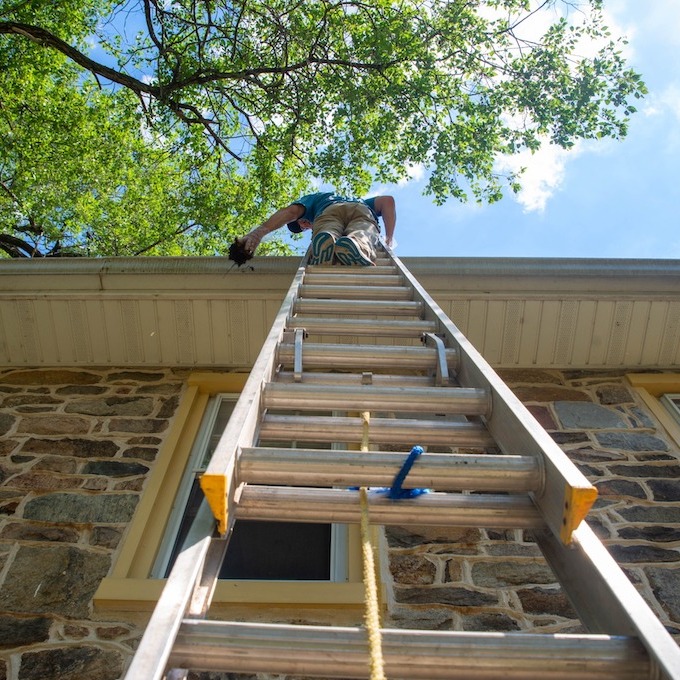
Explaining the Utility of Gutter Installation
The purpose of having gutters on your house isn’t for a ‘finishing touch’ to the exterior, although it does help there! The purpose of gutters is to collect and divert rainwater away from the foundation and landscaping around the house. Gutter repairs make sure the gutters are doing their job in preventing expensive water damage to the home, starting with the foundation, and going upward to the roof.
What are the most causes leading to gutter repairs?
When you notice that your gutter system has issues and isn’t diverting and redirecting the water flow, you should address the matter promptly. Delaying gutter cleaning or gutter repairs will quickly lead to other problems along the foundation and for the roof. The most common issues that lead to gutter repairs are:
- Poor Installation Quality – When a gutter system is improperly installed, eventually, you’ll either need gutter repairs or gutter replacement. By the time it gets to gutter replacement, there is a good chance you’ll need foundation work and possibly a new roof.
- Clogged Gutters – Gutter cleaning is the last thing anyone wants to do, but when left unaddressed, the debris that builds up inside the gutter runs, making it impossible for rainwater to flow through to the downspouts and be diverted from the foundation. If this continues for too long, you’ll need more than gutter repairs.
- Insufficient Size – The size of the house is a determining factor in getting the right size of your gutter runs and of the right number of downspouts in the right placement.
- Disconnected Joint – The joints where gutter runs are connected are important in keeping a constant flow of rainwater. Keeping the joints connected properly is the best gutter repair you can do yourself.
- Improper Pitch – Gutters that aren’t at the right pitch will keep the rainwater from flowing away from the roof and foundation.
What materials and tools are used for gutter repairs?
If you have metal gutters, repairs can be done with strips of metal flashing, roofing cement, tin snips, and sheet metal screws. The steps taken for gutter repair include:
- Thoroughly clean the gutter runs and downspouts.
- Allow time for the gutters to thoroughly dry.
- Measure the holes and cut the metal flashing just a bit larger than the hole.
- Apply roofing cement to the flashing and press it into place.
- Install a few metal screws into the flashing.
- Spread roofing cement over the screw head.
When the gutter repair job is complete, the inside of the gutter run should be smooth so there isn’t anything for leaves and debris to get hung on. This is why it is so important to use waterproof roofing cement.
How often should gutters be inspected for damage?
You should do a monthly walk-a-round of your home for a visual inspection of the roof and gutter repair needs. After any significant weather event that includes high winds or hailstones, you should have a professional inspection for possible roof and gutter repairs.
What are the best methods for gutter cleaning?
For the busy homeowner, or for a person that has a fear of heights, calling a professional gutter cleaning company is the best idea. If you’re a DIY homeowner though, some ways to clean your gutters include:
- Climb up to the roof on a ladder and while walking along the roof edge with a leaf blower, remove any debris and leaves.
- To do this from the ground, there are extension kits for leaf blowers where you can walk along on the ground and blow any debris and leaves out. The downside to doing it this way is if there are large items blocking the gutter runs, like a baseball or nest, you won’t be able to see that can remove them from the ground.
How can you tell if you need gutter repairs?
If you see sagging gutter runs or see holes in the gutter runs, in most cases, gutter repairs are sufficient. When are gutter repairs not sufficient? The 5 most common indications that gutter repairs aren’t enough are:
- Cracking
Cracking or splitting of the gutter runs is only going to get bigger, and then rainwater isn’t going to get diverted and redirected.
- Peeling Paint
If you see peeling paint on the fascia and siding of the house, you need to replace your gutters.
- Orange Flecks
If you have metal gutters, orange flecks in or around the gutters and downspouts are an indication it is time for gutter replacement.
- Pooling Water
If your noticing pooling water at the doors or walkways where gutters should be keeping the water redirected, check for possible gutter repairs, but you may need gutter replacement depending on the age of the gutters and the amount of damage.
- Sagging
If your gutters have been sagging for a long period of time, attempts at gutter repairs by reattaching the gutters runs aren’t going to be sufficient. After a long time of gutter runs sagging, they have lost their stability and can’t be repaired.
In Conclusion
Gutter repairs aren’t something you should ignore “until I have time”, they should be addressed immediately. Like a small plumbing leak, gutter damage is only going to spread and get worse, requiring new gutters and maybe new roofing and foundation work. It’s our job to help out when you need gutter repair in Grain Valley and Kansas City, MO. You can access us at 816-896-4195!